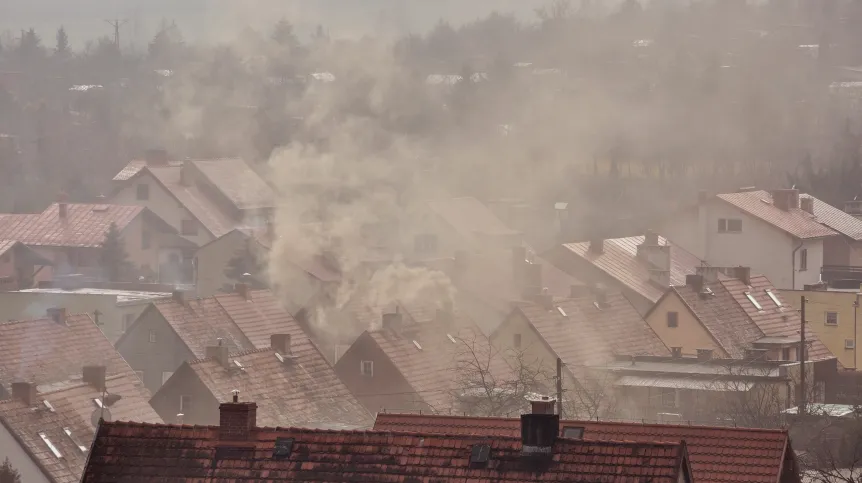
Due to its physicochemical composition, 'Polish smog' is particularly dangerous for the circulatory system, increasing the risk of heart attack and stroke, says cardiologist Dr. Łukasz Kuźma. In his opinion, it is our 'new, infamous regional product'.
This is confirmed by the latest research of the team led by Dr. Kuźma from the Department of Invasive Cardiology of the Medical University of Bialystok, published in the prestigious journal The Lancet.
A worrying result is that the group most exposed to circulatory system problems due to breathing Polish smog are young and middle-aged women.
Classic smog, also known as London smog, is a mixture resulting from the combination of coal combustion products and cool, moist fog. Its appearance was associated with the strong development of industry in Great Britain in the 19th century. How dangerous it could be was discovered in the winter of 1956, when several thousand people died due to the smog lasting for several days.
Over time, it turned out that we have different types of smog with different physicochemical properties and impact on health. 'For example, we have photochemical smog, called Los Angeles smog, which is related to car exhaust fumes and strong sunlight, and Saharan smog, which results from shifting winds and ocean currents. But we also have Polish smog - a new type of air pollution we have defined, forming +around the chimney+’, Dr. Kuźma tells PAP.
Despite the name, however, it does not occur exclusively in Poland, but everywhere where similar weather conditions prevail and the inhabitants are poorer and use low quality heating fuel (coal, wood or rubbish).
According to the researcher, Polish smog differs from other types of smog in several respects. 'First of all, it concerns small towns and rural areas. It forms during frosty high pressures, when the Sun warms the atmosphere and creates conditions for inversion at night. Then the pollutants descend around sources, such as chimneys', says Dr. Kuźma. The third feature that distinguishes Polish smog from other types of smog is its physicochemical composition. 'These are very fine particulate matter and aromatic hydrocarbons, such as benzoalphapyrene. This makes it more toxic to the cardiovascular system than other types of smog', Dr. Kuźma says.
Adding that fine particulate matter with a diameter of no more than 2.5 micrometers directly damages the vascular system, Kuźma says: 'It easily penetrates the endothelium (lining of blood vessels – ed. PAP) in the lungs and has a pro-inflammatory effect throughout the body. For comparison, PM10 (diameter up to 10 micrometers – ed. PAP) does not pass through the endothelium, but induces local inflammation in the respiratory system.’
Long-term exposure to the components of Polish smog, including fine particulate matter and benzoalphapyrene, contributes to the development of atherosclerosis, promotes the formation of blood clots, and, by affecting the autonomic nervous system, it may lead to the development of cardiac arrhythmias and hypertension. If other risk factors for cardiovascular diseases co-occur, such as hypertension, diabetes, obesity, chronic kidney disease, or lack of physical activity, myocardial infarction or stroke may occur more quickly, the cardiologist says. 'In addition, research indicates that, just like stress or a sudden increase in blood pressure, a large increase in air pollution levels can act as a trigger for cardiovascular events. It contributes to the rupture of atheromatous plaque', Kuźma says.
In the latest study, Kuźma’s team analysed data collected in 2011-2020 as part of the Polish Smog project. They concerned 8 million inhabitants of five eastern Polish provinces (Warmian-Masurian, Podlaskie, Lublin, Podkarpackie and Świętokrzyskie), which are not usually associated with smog. Information on hospitalisations due to myocardial infarctions was combined with data on weather conditions and air pollution levels. The focus was on the levels of: particulate matter, benzopyrene and nitrogen dioxide (NO2), sulphur dioxide (SO2) and carbon monoxide (CO).
It turns out that air pollution specific to Poland is more harmful for people under 65 than senior citizens, and more harmful for women than men. 'This means that the group most exposed to circulatory system problems as a result of breathing Polish smog are young and middle-aged women', Kuźma says.
'If an average resident of the analysed area spends 4-6 hours outdoors, the dose of aromatic hydrocarbons to which he or she is exposed corresponds to the dose delivered after smoking six cigarettes', he continues.
This dose is also absorbed by children and young people who do not actively smoke cigarettes. 'This systematically damages their cardiovascular system, which is why we noticed that younger residents were at risk of heart attacks', Kuźma says. In his opinion, Polish smog is 'our new, infamous regional product'.
According to Dr. Kuźma, the study confirms that air pollution is a key factor for public health even in areas generally perceived as free from air pollution. 'Despite the lack of classic industry in these areas, the so-called Polish smog is present there - a type of pollution occurring +around the chimney+. In addition, a harmful lifestyle - especially high consumption of tobacco and alcohol - additionally increases the negative effects of air pollution', Kuźma says. He adds that this is closely related to the lower wealth of residents in the surveyed provinces.
He emphasises that the problem is serious, but we have the opportunity to solve it. All that is needed are the right measures. 'We cannot fight Saharan smog in a systemic way, but we can fight Polish smog, simply by creating better heating systems, using better quality boilers and combustion furnaces, and better quality fuels', the expert says.
His team's calculations show that within a decade, approx. 25,000 myocardial infarctions and ischaemic strokes could be avoided in eastern Poland alone by reducing air pollution to a level that meets the health standards of the World Health Organization. This is approximately 20 percent of all ischaemic strokes and heart attacks, of which a total of 289,000 were recorded during 10 years of research under the Polish Smog project.
According to the authors of the study, the patient's place of residence and the average level of air pollution in the area should be included as a risk factor in models assessing the risk of cardiovascular diseases. 'We also encourage local authorities and doctors to educate patients on the impact of smog on their health, and we encourage patients to use air condition monitoring applications', says Dr. Kuźma.
In the future, the researchers want to create a publicly available online tool that would help estimate the probability of developing cardiovascular diseases for each person, based not only on age and typical medical parameters, but also the concept of ePM-years, i.e. exposure to particulate matter over the years.
The authors of the paper in The Lancet, titled 'Effect of air pollution exposure on risk of acute coronary syndromes in Poland: a nationwide population-based study (EP-PARTICLES study)', are: Łukasz Kuźma, Emil J. Dąbrowski, Anna Kurasz, Michał Święczkowski, Piotr Jemielita, Mariusz Kowalewski, Wojciech Wańha, Paweł Kralisz, Anna Tomaszuk-Kazberuk, Hanna Bachórzewska-Gajewska, Sławomir Dobrzycki and Gregory Y.H. Lip. (PAP)
PAP - Science in Poland, Joanna Morga
jjj/ bar/ js/ kap/
tr. RL













